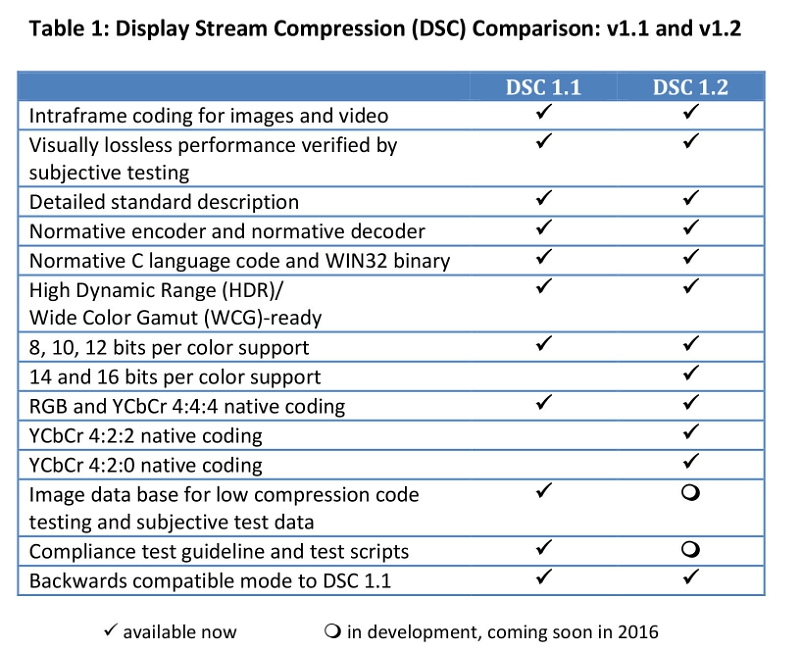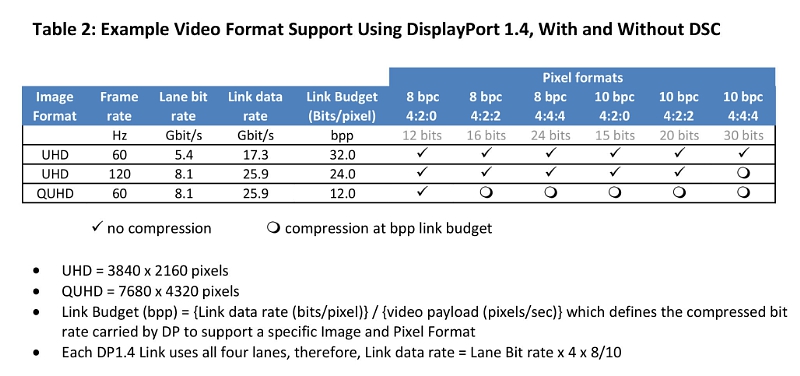 The Video Electronics Standards Association (VESA) announced that it has released version 1.2 of its Display Stream Compression (DSC) standard.
The Video Electronics Standards Association (VESA) announced that it has released version 1.2 of its Display Stream Compression (DSC) standard.
For more information visit: www.vesa.org
Unedited press release follows:
VESA Updates Display Stream Compression Standard to Support New Applications and Richer Display Content
DSC 1.2 features native 4:2:0 and 4:2:2 coding to support up to 16 bits per color; increased compression efficiency increases support of High Dynamic Range content
SAN JOSE, Calif., Jan. 27, 2016 — The Video Electronics Standards Association (VESA®) today announced it has released version 1.2 of the Display Stream Compression (DSC) Standard. An extension to the feature set offered in version 1.1, DSC v1.2 was developed to support a wider range of display applications—in particular, externally connected displays such as PC monitors and televisions. A key feature of DSC v1.2 is its ability to provide native compression of the YCbCr 4:2:0 and 4:2:2 video formats commonly used in digital TVs.
Developed as an industry-wide compression standard for video interfaces that features low latency and visually lossless performance, DSC is currently integrated into standards used for embedded display interfaces within mobile systems. These include the VESA embedded DisplayPort (eDP™) Standard v1.4b and the MIPI Display Serial Interface (DSI) specification v1.2 and later versions. Since its initial introduction in April 2014, the DSC standard has achieved broad adoption in smart phones and tablets, and will be used in future notebook PCs. Examples of mobile processors that currently make use of DSC 1.1 include the NVIDIA Tegra® X1 and the Qualcomm® Snapdragon™ 820.
Dale Stolitzka, principal engineer at Samsung Display and chair of the VESA Display Stream Compression Task Group, noted, “This update to DSC greatly expands adoption opportunities for the standard, which includes within the automotive infotainment and digital TV markets. The update retains all the functionality of the prior version, while adding significant capabilities that will allow makers of a wide range of advanced displays to take advantage of DSC’s many benefits.”
The forthcoming VESA DisplayPort™ (DP) 1.4 specification will be the first DP standard to take advantage of DSC 1.2, which is backward compatible with DSC 1.1. A side-by-side comparison of the two versions can be found at http://www.vesa.org/news-events/press-kits/.
The new capabilities in DSC 1.2 will allow the standard to be utilized not only for mobile displays, but also for emerging high-definition TVs. Key features include:
• Native 4:2:0 and 4:2:2 coding – Eliminates the need to convert pixels into red, green, blue (RGB) components, which allows for direct compression of incoming sub-sampled pixels. This enables more efficient compression (e.g., 2:1 for YCbCr 4:2:0 coding versus 3:1 with RGB conversion), which in turn results in superior image quality for digital TVs, which often utilize YCbCr 4:2:0 coding.
• Up to 16 bits per color – Expands the number of bits per color that can be used, supporting native pixel coding at 8, 10, 12, 14 and 16 bits per color for input and output formats. DSC 1.1 supported only 8, 10 and 12 bits per color. The additional support of 14 and 16 bit depth allows complete compatibility with existing transports and wide color depth pixel formats—enabling the display of very high color depth content.
• High Dynamic Range (HDR) – HDR TV shows and movies are becoming available for on-line streaming, and Ultra HD Blu-ray™ discs with HDR titles are expected to hit the market soon. Because the higher color depth of HDR requires more data, the increased compression efficiency of 4:2:0 format by DSC 1.2 and through the soon-to-be-launched DP 1.4 transport specification (which recognizes the BT.2020 color standard) will be a key enabler for driving adoption of HDR TV technology—especially as resolutions increase beyond 4K.
“IP availability to the semiconductor industry plays a vital role in enabling this important compression standard for advanced, high-resolution displays,” said Alain Legault, VP of IP products for Hardent. “Our DSC-compliant encoder and decoder IP cores provide a low-risk, proven solution, allowing manufacturers to rapidly integrate the standard and meet their time-to-market windows.”
Added Craig Wiley, senior director of marketing for Parade Technologies and VESA board member, “The display industry is moving in exciting directions, and through the collaboration of our more than 230 member companies and liaisons with other standards organizations, VESA’s publication of DSC 1.2 enables a standardized display interface compression codec that will unleash a new level of display performance capability across multiple ecosystems. Similar to other VESA standards, DSC is available for use in display interface standards published by other organizations—further strengthening its value compared to proprietary standards that can’t match its visually lossless, low-power image compression.”
About VESA
The Video Electronics Standards Association (VESA) is an international, non-profit standards association representing a global network of more than 230 hardware, software, computer, display and component manufacturers committed to developing and promoting the electronics industry. VESA has an established 25-year track record of creating and supporting simple, universal and cross-product solutions for today’s video and electronics industry. The association’s standards include DisplayPort™, the industry replacement for DVI, LVDS and VGA. DisplayPort utilizes a state-of-the-art digital protocol and provides an expandable foundation to enable astonishing digital display experiences. For more information on VESA, please visit http://www.vesa.org/.

